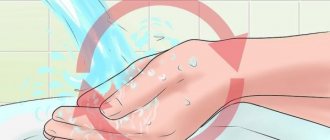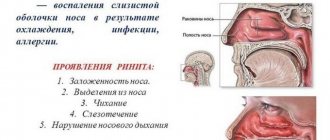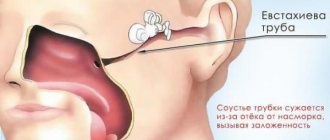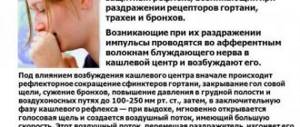Why is it difficult for a person to breathe with bronchitis, how to help a person with an attack of shortness of breath
Difficulty breathing is a dangerous symptom that can disturb anyone.
The course of bronchitis is accompanied by a large number of symptoms. When a patient has difficulty breathing during bronchitis, this is a sign of a complicated course of the disease, which means that the body will now need additional help to restore normal breathing.
How does bronchitis manifest?
The main manifestation of bronchitis is the development of inflammation in the tissues of the bronchi. This process is accompanied by symptoms:
- increase in body temperature in response to the inflammatory process;
- general weakness, as the body sends all its strength to protect itself and fight the cause of inflammation;
- Coughing helps remove mucus and clears the lungs for proper breathing.
A symptom such as difficulty breathing during bronchitis should be alarming. After all, this indicates insufficient air supply.
What is the complaint “hard to breathe”?
What to do if your child has difficulty breathing after bronchitis - consult a doctor as soon as possible
Heavy breathing is a sign of the development of shortness of breath, otherwise called dyspnea. This syndrome develops in response to inflammation in the bronchi.
Shortness of breath can be determined by the following signs:
- breathing is difficult when exhaling, when inhaling, or in both cases, and the attack is not preceded by a period of physical activity;
- coughing becomes more frequent, as the body tries to expand the bronchi and free breathing;
- the patient feels compression of the chest;
- with severe shortness of breath, pain is felt in the sternum;
- there is a feeling that there is not enough air to breathe.
Important: in addition to inflammation in the bronchi, shortness of breath can indicate other serious problems. Heart problems can also cause you to feel short of breath
Choking can overtake a person not only when he suffers from inflammation of the bronchi, but also in the following situations:
- if a person accidentally inhales a foreign body;
- in the presence of cancer in the chest area;
- if the patient has bronchial asthma;
- in the presence of cardiovascular problems;
- with pneumonia;
- if pneumothorax develops.
The resulting shortness of breath can develop into an attack of suffocation - this condition is very dangerous for a person and requires assistance. It is difficult for an ordinary person to determine the reason for the feeling of difficulty breathing, which means that the sick person or the person nearby needs to immediately dial the ambulance number.
If shortness of breath occurs, it is necessary to prevent the development of shortness of breath
Different types of difficulty breathing
Shortness of breath, with its inherent difficulty in breathing, manifests itself in different forms. Various manifestations depend on what type of bronchitis a person has suffered.
Table No. 1. Types of bronchitis and features of shortness of breath:
Type of bronchial inflammation How shortness of breath manifests Solution to the problem
Acute Typically, shortness of breath does not appear at all. If it does appear, this indicates the addition of complications to acute bronchitis. This occurs when treatment is insufficient, which means that to alleviate the condition, the therapy will have to be reconsidered.
ChronicRespiratory problems most often occur with this type of disease. The more often the disease recurs, the more severe the shortness of breath will become. Patients often complain of chest pain. If treatment is insufficient, suffocation will develop.
Therapy for a chronic condition is very complex, and must be managed by a pulmonologist. Allergic Difficulty breathing develops when an allergen is directly nearby, tactile contact with it, or consumption of a product that causes a reaction. The condition improves when contact with the allergen is stopped.
Taking antihistamines once can also help. Further treatment is controlled by an allergist-pulmonologist. Obstructive course Dyspnea during obstruction is a common occurrence when viscous sputum is actively produced, which accumulates, deforms the bronchial tree and significantly narrows the lumen of the bronchi.
A patient with obstruction should be treated as soon as possible. If severe shortness of breath and suffocation develops, emergency assistance is needed.
Important: people with bronchial asthma should be especially careful; for them, bronchitis may drag on and require longer treatment.
Why it becomes difficult to breathe and how it is treated
When treating lung disease, you need to solve several problems at once
Shortness of breath develops for some reasons, knowing them, it is possible to develop a mechanism for treating it in case of bronchitis.
Table No. 2. Causes of shortness of breath and medication methods to combat them:
The mechanism of development of shortness of breathMethods of dealing with the problem
The inflammatory process causes swelling, tissue cells increase in size. So the lumen of the bronchi decreases, and it becomes difficult for air to circulate through them.
The use of anti-inflammatory drugs, as well as inhalations to directly affect inflamed tissues. Active fight against infection causes intensive formation of mucus and sputum.
If these substances are too thick, it is difficult to remove them with a normal cough, then when they accumulate, they cause breathing problems in a person. To successfully cough up the sputum, it is necessary to liquefy it, for this purpose mucolytic drugs are used.
When the bronchi become inflamed, not only the tissues lining them are affected; muscle fibers can also be damaged. Then the bronchi lose their natural ability to expand when required. Antispasmodics help well with spasms of the smooth muscles of the bronchi. They make it possible to breathe freely and also facilitate the discharge of sputum.
The complexity of treatment for bronchitis is of fundamental importance. The more effort a person puts into his own recovery, the sooner he will be able to return to everyday life and work.
Patients with asthma know firsthand the feeling of suffocation. Important: if the disease recurs too often or lasts for a long time, the doctor will prescribe antibiotics for use. You should not be afraid or neglect these drugs; if they have been prescribed, then the body cannot do without them.
When to Seek Emergency Help
Important: a state of suffocation dangerous to human health can develop in just a few seconds; you cannot hesitate in such situations.
Patients with respiratory diseases in the acute stage or with complications of the disease should not be left alone without supervision, because a sharp deterioration in their condition can occur at any time.
Doctors will assess the patient’s condition and, if necessary, transport him to the hospital
There are signs that indicate that a patient is in need of emergency medical care:
- Breathing becomes frequent, but shallow. The man seems to be unable to breathe.
- With the naked ear you can hear wheezing and whistling in the chest when breathing.
- Children are characterized by a sudden onset of lethargy and apathy.
- Inhalation or exhalation is markedly difficult and occurs more slowly than the reverse action.
- The patient lost consciousness or the complexion of the face suddenly acquired a sallow or bluish tint - these are all dangerous signs of an acute lack of oxygen.
- Neurological signs of lack of air occur - convulsions, which are more common in children.
First aid for shortness of breath
The main thing when shortness of breath while waiting for a doctor is to calm the child
As soon as the first symptoms of a developing attack of shortness of breath appear, you need to seek emergency medical help. While waiting for the doctors to arrive, there is a way to alleviate the patient’s condition and slow down the increase in difficulty breathing.
How to help your child
The condition of deteriorating breathing in a child is very dangerous, because a small person cannot always clearly communicate his condition.
Important: children are much more difficult to endure attacks of deterioration in breathing due to bronchitis.
The peculiarity of this condition in a child is complicated by childhood fear.
It is difficult for a child to calm down on his own; to do this, while waiting for the doctor to arrive, you should try to do the following:
- sit the child upright, put additional support under his back, a pillow is best, you can use any bulky fabric object;
- you need to try to distract the baby from his condition; the less the child focuses on his poor health, the less he will worry;
- it is worth freeing the chest area so that there are no clothes on it, it is worth getting rid of high collars, they can create the appearance that it is the clothes that are interfering with breathing;
- if possible, air humidification helps a lot; if there is a humidifier in the house, it is worth using; if the child does not have an elevated body temperature, then you can create a humid atmosphere in the bath;
- If you have a nebulizer, you should do inhalations with saline solution.
Important: for a person experiencing an attack of shortness of breath or suffocation, it is very important that the people around them remain calm and do not panic.
If attacks occur periodically, the attending physician may prescribe bronchodilators for self-administration - Salbutamol, Berodual for inhalation. They are diluted in saline solution as directed by the doctor and inhaled through a nebulizer until the attack is stopped or until the doctor arrives.
A nebulizer in the house will greatly help when the need for urgent inhalation arises
The photos and videos in this article will help you understand how to use the nebulizer correctly and prevent it from breaking.
Important: a nebulizer is an electric inhaler that can be purchased for home use; treatment of diseases of the upper and lower respiratory tract with its help is very effective; people with frequently recurrent or chronic diseases should purchase it, as well as if there are small children in the house.
How to help an adult
In adults, bronchospasm also occurs against the background of chronic or complicated bronchitis. A person in this condition should call an ambulance and get help.
The following instructions will help you understand what you can do:
- if the patient is lying down, then he should be raised to a sitting position; this can be done by placing a large pillow under his back;
- the chest area needs to be freed from excess tissue;
- it is necessary to provide additional air flow into the room;
- Even an adult will not be harmed by the presence of a calm assistant nearby; calmness will help lower the pulse and make breathing a little deeper;
- if the patient has already been prescribed the use of a nebulizer or inhaler with medication, they should be used.
If shortness of breath in an adult or child occurs due to contact with an allergen, then you should immediately stop contact with the causative agent of the problem and give the victim a single dose of an antihistamine, according to the instructions.
Allergic shortness of breath can be prevented by avoiding contact with the pathogen
For an adult, Suprastin is best suited; for a child, a drug in the form of drops, for example, Fenistil, is preferable.
When a doctor arrives to see a sick child or adult, the person nearby or the patient himself should tell about what is happening:
- for what reason the attack occurred and how long it has lasted;
- if there is a long-term or chronic lung disease, it is worth talking about its characteristics and duration of course;
- it is necessary to report what measures have already been taken to alleviate the patient’s condition, and what effect this had.
If the emergency doctor decides to hospitalize, the patient needs to pack with him the medications and inhalers that were prescribed for treatment.
Treatment
To be completely sure of the nature of the occurrence of shortness of breath, you need to conduct an examination.
Shortness of breath may occur after the underlying disease has subsided. This means that dyspnea requires special treatment.
Important: the end of bronchitis does not mean the end of shortness of breath.
In addition to medications prescribed by a doctor, a specialist may recommend the use of home treatments. If the patient does not have an elevated body temperature and his condition has stabilized, then home treatment methods can be successfully used.
Diseases of the respiratory tract respond well to treatment with folk remedies, if they are followed according to the rules and taking into account contraindications.
Here are some guidelines to follow when treating at home:
- the patient’s condition should stabilize, and body temperature should not be elevated;
- all treatment must be prescribed by a doctor who treats breathing problems;
- the patient should not be allergic to the drugs used.
To treat shortness of breath, traditional medicine recommends using:
- hawthorn flowers;
- chopped lemon balm;
- honey;
- boiled potatoes;
- garlic;
- contents of walnut shells.
Important: shortness of breath once occurring can recur at any time.
Methods for treating shortness of breath depend on the cause and condition of the patient. You can find out whether you can breathe over potatoes during bronchitis, drink herbal infusions or make compresses only from your attending physician.
Timely seeking help will help you get rid of shortness of breath forever.
Treatment for bronchitis should be prescribed by a doctor, because only a knowledgeable specialist can prescribe complex treatment, which is so important in the treatment of bronchitis. The cost of self-medication for lung disease is too high - there is a risk of aggravating the disease, and it will become a chronic condition.
Timely and high-quality treatment of bronchial inflammation is quite capable of preventing the situation that after bronchitis it is difficult to breathe. Paying attention to your health and the health of your loved ones makes it possible to prevent not only the development of shortness of breath, but also other serious complications.
Read more…
Source: https://zen.yandex.ru/media/id/59bf9ecc9d5cb3ee0df4e084/5a0d47a786516515bab4e3c7
What should you do if you have a cold?
A timely visit to the doctor is the key to a quick recovery. You should seek professional medical help if you experience general malaise, increased body temperature, or severe signs of a respiratory infection. A specialist will listen to complaints, make an accurate diagnosis, give recommendations for treating a cold, or prescribe a good remedy for the flu for an adult. Doctors often prescribe Derinat. This is a complex remedy with a reparative effect. Available in the form of a spray and nasal drops. It acts in several directions at once:
- helps the immune system fight viruses - the main causative agents of respiratory infections;
- activates the body’s own defenses, but does not overload the immune system;
- restores and strengthens the mucous membrane of the nasopharynx - a natural barrier to pathogenic agents transmitted by airborne droplets, reduces the risk of developing repeated episodes of colds, flu and acute respiratory viral infections.
Cough, difficulty breathing and lack of air: causes and treatments
When a person has a cough, difficulty breathing, or shortness of breath, he should consult a doctor. He will determine the exact cause and prescribe the correct treatment.
In most cases, such symptoms are a sign of infectious or viral diseases of the respiratory tract, but it happens that they are caused by more serious pathologies.
The sensations can be different - from the desire to breathe in more air to acute pain. Environmental factors aggravate cough and breathing problems.
Causes of cough with difficulty breathing
If a person has difficulty breathing, a cough appears, and the breath begins to catch, perhaps this is a sign of acute respiratory diseases or more serious pathologies. Breathing problems due to coughing occur due to the following reasons:
- bacteria or viruses enter the mucous membranes of the respiratory system;
- the amount of mucus that constricts the bronchi increases;
- due to infection, spasms and swelling of the bronchi occur.
These processes prevent a person from breathing, as a result of which he experiences a lack of oxygen.
Inflammatory diseases of the respiratory tract
When a dry cough appears and it’s hard to breathe, this often indicates a bacterial or viral infection of the respiratory system:
- Acute bronchitis. Severe pain occurs due to inflammation of the bronchial mucosa. The acute form begins suddenly and is accompanied by a dry cough that presses on the chest, shortness of breath after attacks and minimal physical activity, and general malaise (fever, weakness, headache). As the disease progresses, a cough with white or green sputum appears.
- Laryngitis, which affects the ligaments. After infection, the throat becomes red, swollen, and it hurts the person to breathe, cough, swallow, or talk. Moreover, the aching pain does not go away even at rest. In most cases, laryngitis is accompanied by weakness and fever. A dry cough can last up to 3 weeks, after which it changes its character and becomes productive.
- Pharyngitis is a lesion of the tonsils in the throat. A suffocating dry cough begins as a result of throat strain and spasms with hoarseness and sore throat. It develops several days after infection and is accompanied by all the signs of a respiratory disease (weakness, headache, fever). The attacks intensify at night, which causes a lot of suffering. In the case of chronic pharyngitis, spasms become persistent and become debilitating. There is a constant desire to swallow, it seems that something is stuck in the throat.
- Tracheitis is inflammation of the trachea due to infection or allergy. It is characterized by attacks of dry cough with the release of purulent sputum (in the case of a bacterial disease), shortness of breath, wheezing, and raw pain in the chest. The most severe spasms occur at night, when the patient cannot breathe normally.
- Flu. Accompanied by a dry, debilitating cough and pain in the sternum. This is the body's reaction to the pathogen. Sputum begins to be produced only on days 3-4.
- Whooping cough. This is an infectious disease that affects the respiratory system. At the beginning of the disease, the cough is no different from the cough during ARVI. At the second stage, attacks appear with a characteristic whistle when inhaling. The spasm continues until the mucus blocking the airways is released. In this case, the patient’s face turns red, swells, his tongue protrudes from his mouth, and it becomes difficult for him to breathe.
- Pneumonia is the cause of inspiratory shortness of breath (that is, when inhaling). The larynx and trachea swell, and a spasm of the gap appears. A person feels pain in the sternum, his body temperature rises, and there is a strong cough with sputum (possibly streaked with blood). It becomes difficult to breathe throughout the day, not just at night.
Bronchial asthma
This is a serious disease of the respiratory system that is difficult to treat.
During an attack, it becomes difficult for the patient to breathe, and a dry cough irritates the throat, and he begins to choke.
Severe shortness of breath and lack of air also appears, the skin of the face turns blue, and the throat gets sore.
The main cause of asthma symptoms is spasm in the airways. Seizures can be triggered by:
- air pollutants;
- allergens (pollen, animal hair, mold, dust);
- stressful situations;
- hypothermia;
- viral respiratory infections;
- excessive physical activity;
- smoking;
- some food products;
- medications;
- hormonal disbalance.
Upon contact with provoking factors, the muscles in the walls of the bronchi begin to contract, as a result of which the airways become narrow. The tissue that lines them swells, sputum forms on it, which leads to asthmatic attacks. It becomes difficult for the patient to breathe.
In some cases, asthma attacks are so severe that they can lead to death if not stopped in time.
Allergies increase the susceptibility of the bronchi to inflammation and irritation. Against this background, a mixed type of asthma of severe and moderate severity develops. If a cough appears and it becomes difficult to breathe, these may be signs of a paroxysmal attack, which can also be accompanied by wheezing as you exhale and tightness in the chest. The condition improves after sputum is discharged.
Pulmonary tuberculosis
Heavy breathing can occur with tuberculosis. This is an infectious disease caused by Koch's bacillus. May be accompanied by a prolonged cough due to a constant inflammatory process in the area of the bronchi and their branches.
The patient does not have enough air, strong wheezing constantly irritates the throat. After a coughing attack, shortness of breath occurs, pain is localized in the chest, and the person cannot breathe normally.
With tuberculosis, different types of cough can be observed:
- Wet - accompanied by the release of sputum, accumulating in the upper respiratory tract.
- Dry without mucus separation.
- Mixed with periodic expectoration of mucus.
With a latent form of tuberculosis, the cough is not strong, more dry.
During the development of the disease (infiltrative form), the accumulated sputum is released with particles of blood. In the cavernous form, the patient has difficulty breathing, dull wheezing in the lungs, hemoptysis, and purulent discharge when coughing. In case of total damage to the lungs, attacks become intolerable.
In the primary form of the disease, tuberculous bronchoadenitis may occur. Most often, school-age children suffer from this pathology. It may be asymptomatic or with a non-productive paroxysmal cough without secretion.
Shortness of breath with cough due to diseases of other organs
When a cough appears and difficulty breathing, this may indicate the following pathologies and conditions:
- Heart failure due to impaired blood flow. As a result, a person develops a cough with shortness of breath, chest pain, bluish skin, and increasing tachycardia.
- Emphysema is one of the disorders that belongs to chronic obstructive pulmonary disease (COPD). Occurs in most cases in experienced smokers. In addition to a strong wet cough, during which it is difficult to clear the throat, it becomes difficult to breathe, and shortness of breath appears.
- Panic attacks, as a result of which a person lacks air, and there is often no cough. Occurs due to anxiety or stress.
- Nervous exhaustion from constant stress. A person begins to have difficulty breathing due to a general weakened state.
If it is painful for a person to breathe when exhaling, this symptom is called expiratory dyspnea. Appears with hypertension, metabolic disorders, anemia, ischemia, cardiac asthma, pulmonary embolism, and excessive dosage of narcotic and sleeping pills.
Why does a child have difficulty breathing when coughing?
A severe cough in a child may occur due to laryngotracheitis (false croup). Most often it affects children from 2 months to 6 years. It starts out like a common cold. It manifests itself as a strong barking cough, wheezing inhalation, pronounced swelling of the larynx, and hoarseness of voice. The child has difficulty breathing at night and complains of lack of air.
In young children, the cause of heavy breathing lies in increased salivation and accumulation of snot in the nasopharynx. Dry, too warm air in the room worsens the symptoms.
When a baby has difficulty breathing, this may be a sign of adenoids, measles, diphtheria, otitis media, allergies and any respiratory diseases. The exact cause is determined by the pediatrician.
If, during a coughing attack, the baby develops wheezing, suffocation, or the nasolabial triangle turns blue, it is possible that a foreign object has gotten into the throat.
Help with dry, severe cough
When a person has a cough and difficulty breathing, the first thing to do is see a doctor who will prescribe an examination. Seizures can be treated after an accurate diagnosis. If a bacterial or viral infection is detected, the following drugs are prescribed:
- The proliferation of bacteria is prevented by antibiotics: Macropen, Sumamed, Erythromycin.
- A dry cough against the background of viral inflammation will go away faster if you take antiviral drugs: Amiksin, Arbidol, Lavomax, Genferon, Ergoferon.
- Natural products help transform a dry cough into a wet one in children: Prospan, Gedelix. Adults are prescribed stronger medications - Ambroxol, Lazolvan.
- To make it easier to breathe, it is necessary to increase the clearance in the bronchi. The drugs Flunisolide, Budesonide, Volmax, Beclomethasone, Salmeterol help with this. These medications also relieve inflammation.
- In case of debilitating cough, Sinekod, Stoptussin, Bronholitin are suitable. These medications quickly suppress the cough reflex.
- To restore the function of the mucous membrane of the lungs and bronchi, the following are prescribed: Doctor Mom, Codelac Broncho, Travisil, Linkas, Gerbion, Amtersol. They help a person breathe normally.
- Allergic attacks are stopped with antihistamines: Suprastin, Zodak, Zyrtec, Loratadine.
Cough in children and adults, which is accompanied by difficulty breathing, is well treated through inhalation. It is convenient to use a nebulizer for this.
You can breathe with regular saline solution, add Borjomi mineral water, Lazolvan and other mucolytics.
Folk remedies will also help relieve attacks:
- milk with honey and soda (200 ml, 1 tbsp and ¼ tsp, respectively);
- black radish with honey;
- herbal decoctions of chamomile, thyme, calendula, licorice root, sage (2 tablespoons of dry herbs per 200 ml of boiling water).
If it is difficult to breathe when coughing, you need to establish optimal conditions in the room. Ventilate frequently, humidify the air to 45-60% (it is better to use a humidifier), and carry out wet cleaning. If you don’t have a fever, you should try to spend more time outdoors. To expel sputum, it is recommended to drink as much warm liquid as possible: fruit drinks, compotes, rosehip decoction.
Source: https://tden.ru/health/kashel-tyazhelo-dyshat
I can’t breathe: what to do if your nose is stuffy?
It’s hard for you to breathe, you don’t have enough air... Alas, this is not love. Your nose is just stuffy. Yesterday’s slight runny nose today threatens to put you to bed for a long time, ruin all your plans, mood and significantly spoil your health. What needs to be done to avoid complications - sinusitis, otitis media and other troubles?
Otolaryngologists do not consider nasal congestion an independent disease and classify it as a sign indicating a particular disease. Your nose may not breathe, for example, due to allergies or ARVI. The only problem is that, despite different causes, the symptoms are almost always the same: sneezing, swelling of the nasopharynx, itching, discomfort in the nose, headache. Even the most common runny nose can last for two weeks.
How to deal with a runny nose?
A runny nose appears, first steps
Any disease is a consequence of something. Before you start treatment, run to the pharmacy and analyze why your nose is stuffy. Maybe you didn’t dress warmly enough yesterday, stood at the bus stop for a long time and got hypothermia? Or I went out of the warm room into the street, just for five minutes, to get some air and take my mind off work. Namely, a sharp contrast in temperature often leads to a cold. In this case, any nasal drops purchased at the pharmacy (tizin, naphthyzin, sanorin, etc.) will help against a cold. If the cause of nasal congestion is not known to you, do not rush to take medications. What if it’s allergic rhinitis, adenoids, polyps, deviated nasal septum?
Don't miss the moment: fighting a runny nose at home
It also happens that a couple of hours ago you felt great, but when you came home, your body relaxed, and you felt with every part of your body that you were sick. To prevent your runny nose from getting worse, immediately start doing useful procedures: soak your feet in hot water with mustard (if there is no high temperature); “drive” tea with raspberries, lemon, linden; put mustard plasters on the calf muscles. Another very effective remedy is rinsing the nasopharynx with a saline solution with the addition of eucalyptus or calendula tincture (1 teaspoon per 0.5 cup of water). Or, several times a day, bury your nose with freshly squeezed carrot (beetroot, onion) juice, which is diluted 1:1 with boiled water.
It will go away in a week: don’t bother with treatment
They say that a runny nose goes away on its own after a week, whether you treat it or not. In reality, if you leave everything to chance, you can get various complications, such as sinusitis. Doctors advise treating colds from the first day. But self-treatment is limited to two to three days, and then, if nasal congestion does not go away, it is better to consult a doctor.
A trivial runny nose: why see a doctor?
Is your health a small thing? According to statistics, almost twenty percent of rhinitis results in otitis media, sinusitis, tonsillitis and other complications. And only if you consult a doctor in time, all these problems can be avoided.
To get relief: time-tested methods
One of the effective means to quickly cope with a runny nose is considered to be a remedy for sailors. A special drink helped them overcome a cold in one evening. You can cook it too. But due to the alcohol content, it is only suitable for adults.
Take 0.5 liters of red wine, pour into a saucepan and place on medium heat. Heat the wine, but don't let it boil. Before removing from heat, pour in 1 teaspoon of rum (vodka, cognac), add the juice of one lemon, on the tip of a teaspoon of ginger, two cloves, and a little cinnamon. And lastly, honey is added, 1 tablespoon is enough. It is recommended to drink the drink hot, in small sips, as if savoring it, and inhale its vapors. In this case, the person who has a cold should be completely wrapped in a blanket or blanket. This procedure is carried out at night.
You can also use a non-alcoholic method for colds - this is what our grandmothers did. Take a cloth, soak it in kerosene (vodka), wring it out and apply it to the soles. Then put on wool socks and go to bed.
Or boil potatoes in their jackets and give your nose a “steam bath”. Cover yourself with a blanket and breathe in potato vapors for ten to fifteen minutes. It is also good to carry out such inhalation with the addition of essential oils of eucalyptus and pine, known for their bactericidal properties to kill viruses and pathogens. You can also use tea tree oil, cypress, mint, which are classified as anti-sinusitis remedies. The choice depends on individual tolerance.
To stop a runny nose, apply a little tea tree or lavender essential oil to the sides of your nose before going to bed. Instantly penetrating the skin, it will prevent the disease from progressing. This procedure is useful for all family members to prevent colds.
Cough and shortness of breath
Every person encounters such a symptom as cough quite often. But sometimes it can be accompanied by shortness of breath, which is very dangerous. When the patient coughs, severe wheezing can be heard and shortness of breath appears. Before starting treatment, it is worth understanding the cause of the cough. Coughing and shortness of breath can signal the development of serious illnesses.
Mechanism of symptom formation
In the overwhelming majority, it is coughing attacks that are the source of lack of air. Due to cough and bacteria on the mucous membrane of the respiratory tract, very severe irritation appears. And the air becomes the same pathology as bacteria.
For this reason, it pushes out air along with mucus and phlegm. And as a result, the patient simply physically cannot take a breath and severe shortness of breath appears. The stress that a person experiences in this case further aggravates the situation and shortness of breath becomes stronger.
The state of lack of air is also called dyspnea. How it is formed:
- virus or bacteria enter the mucous membrane of the respiratory tract;
- swelling of the bronchi develops, spasms begin;
- the volume of mucus increases;
- the body, with the help of a dry cough, tries to get rid of phlegm;
- it is difficult for a person to breathe, there is not enough air - shortness of breath appears.
Such symptoms may indicate the development of bronchitis or asthma. In a healthy person, when you inhale, oxygen comes in, and when you exhale, carbon dioxide comes out.
But with pneumonia, asthma or other respiratory diseases, obstacles arise. The blood does not receive enough oxygen and breathing becomes difficult.
In addition to coughing, shortness of breath can also cause the following symptoms:
- increased heart rate;
- strong fear;
- shortness of breath;
- yawning;
- fainting.
Depending on the disease, these symptoms may vary in duration.
Causes of difficulty breathing
Whatever the cause of the cough and lack of air, you need to get rid of it as quickly as possible.
Bronchial asthma. This disease is characterized by:
- dry cough;
- shortness of breath;
- difficulty breathing;
- wheezing with whistling.
You may be interested in the article - The main symptoms of cough with VSD.
Asthma attacks occur for various reasons:
- contact with an allergen;
- hypothermia;
- previous cold;
- exercise stress.
Chronical bronchitis. Accompanied by a constant productive cough and periodic shortness of breath. But lack of air is observed less frequently. Mostly it occurs during an exacerbation of the disease or after physical training.
You may be interested in the article - What are the reasons that a child coughs and chokes?
Attacks of suffocation are also observed in the following diseases:
- pneumonia;
- tuberculosis;
- emphysema;
- swelling of the ligaments;
- bronchial obstruction;
- foreign body in the respiratory tract.
Upper respiratory tract diseases also cause shortness of breath:
- laryngitis;
- sarcoidosis;
- aortic aneurysm;
- tuberculous bronchoalenitis.
In addition to the feeling of lack of air, in such cases a dry cough is also observed.
Shortness of breath in other diseases
Dyspnea is not an independent disease of the respiratory organs. This is a symptom. There are a number of reasons that can cause shortness of breath. For example, lack of air can occur due to heart pathologies. It can bother you even during rest. What this may indicate:
- angina pectoris;
- cardiac ischemia;
- previous heart attack;
- cardiac asthma.
With obesity, adipose tissue creates additional stress, settling on internal organs. The lungs and heart cannot work normally and the flow of oxygen to the tissues and blood decreases.
Under severe stress, adrenaline is released into the blood. Metabolism speeds up, resulting in faster oxygen consumption. Therefore, sometimes a person feels short of breath in stressful situations. People who experience panic attacks and hysterics often experience asthma attacks.
Other causes of shortness of breath:
- anemia;
- chest injuries;
- vascular diseases;
- allergy,
- pregnancy;
- problems with the thyroid gland;
- insufficient physical activity.
Expiratory dyspnea
Expiratory shortness of breath indicates pathologies of the lungs or other organs. It represents difficulty in exhaling. What physiological changes cause this problem:
- decreased elasticity of the lung walls;
- allergic reaction;
- contraction of the lung muscles;
- compression of bronchioles.
You might be interested in the article - What to do if you are bothered by a wheezing cough?
What are the signs by which expiratory dyspnea can be distinguished:
- chest pain during exhalation;
- bluish lips;
- pale skin;
- general weakness.
- severe wheezing and whistling sound during exhalation.
We recommend reading: Weakness and cough: what do these symptoms mean?
Expiratory shortness of breath occurs for the following reasons:
- exceeding the dose of sleeping pills or narcotic drugs;
- bronchial obstruction;
- hypertension;
- metabolic disorder.
In order for shortness of breath to disappear, the root cause of its occurrence must be identified and eliminated. Depending on the disease, medications for its treatment differ:
- Fenoterol, Berotek, Salbutamol are prescribed for the treatment of asthma. These drugs eliminate spasms in the bronchi. Inhalations are also recommended.
- For cardiac dyspnea, cardiac glycosides, beta-blockers and antiarrhythmic medications are prescribed.
Read this article about how to treat cough when inhaling.
The doctor may also prescribe massages, breathing exercises and UHF therapy. In addition to basic treatment, patients need to follow some rules:
- Avoid smoking to clear nicotine from your blood.
- Carry out physical rehabilitation to improve the body's condition and ensure stability during training.
If an attack of suffocation occurs, the patient needs to sit in a chair and wait for the doctor. In the room where the patient is located, the air should always be clean and humid. For better hydration, you can hang wet towels and always keep containers of water. The patient also needs to avoid stress.
Inspiratory dyspnea
Inspiratory dyspnea is difficulty breathing when inhaling. This is also not a disease, but only a symptom of it. To identify the cause, you need to undergo examination in a hospital. Possible causes:
- Psychological trauma, nervous overstrain. How it manifests itself:
- general weakness;
- headache;
- tingling in the arms and legs;
- dizziness.
- Foreign objects in the respiratory tract:
- coughing attack;
- lack of air;
- heaviness in the chest.
- general weakness;
- migraine;
- cyanosis of lips and fingers.
- Blood clots in the pulmonary artery:
- chest pain during the slightest physical activity;
- irregular and rapid pulse;
- pain when coughing and inhaling;
- increased sweating.
You might be interested in the article - Why does a cough appear during physical activity?
Sometimes shortness of breath occurs during physical exertion. This is an absolutely normal reaction of the body to activity and does not indicate illness. You should worry in cases where lack of air appears at rest or during sleep.
How to relieve shortness of breath and cough
Before treating shortness of breath and cough, you need to see a doctor to diagnose and identify the cause of these symptoms. The next step is to eliminate all allergens in the house:
- spirits;
- antiperspirants;
- cigarette smoke;
- household chemicals.
To treat the respiratory system, doctors most often prescribe:
- bronchodilators;
- inhalation;
- hormonal drugs;
- expectorants;
- antibiotics.
Breathing exercises for coughs will also be very useful. Its effect will be noticeable in about a few weeks.
If you have heart disease, you need to follow a special diet. It is worth excluding salty, spicy, smoked and canned products. The diet should include more vegetables and fruits, greens and dairy products. The patient should walk more in the fresh air. Vasodilators and diuretics will help strengthen the heart muscle. You also need to avoid stress and get rid of bad habits.
Symptoms of the disease
What sensations does the patient experience with this inflammation?
How does he feel that it is difficult to breathe?
In general, the first manifestations of inflammatory lung disease are cough and high body temperature.
Breathing rhythm
Further, as the disease worsens, the number of respiratory movements increases. Under normal conditions, the chest lowers and rises 16-18 times per minute.
Breathing rhythm
With the onset of respiratory failure, this figure increases to 20-22 times.
Then, as the symptom progresses, a further increase in frequency is possible.
An increase of more than 24 bpm at rest should be alarming. In addition to shortness of breath, the body compensates for oxygen deficiency by increasing the number of heartbeats and the appearance of tachycardia.
The patient tries to find a comfortable position. He no longer lies horizontally, but is in a semi-sitting state.
To increase oxygen delivery, takes deep breaths. From the outside it seems that he sighs often.
If it is possible to compensate for the delivery of oxygen at this stage of the disease, then gradually the state of health returns to normal and the frequency of respiratory movements and heartbeats is restored.
Intense cough in children
As you know, children suffer most diseases much more severely, because an unformed body is more susceptible to attack by viruses and infections. If a child is choking from coughing, parents should carefully address this issue. In most situations, the symptom in question is associated with respiratory diseases. However, there are exceptions: a cough may indicate problems with the gastrointestinal tract or disorders of the cardiovascular system. Convulsive exhalation with wheezing also occurs when a foreign body enters.
Additional symptoms will help determine the cause. For example, weakness in the body and weight loss occur with a dry cough. A child may suffocate even if he has tuberculosis and tumor lesions. As for the treatment of the symptom, it is better to leave this issue to the doctor. First, he will make a diagnosis and then formulate the most effective treatment in this situation. Often, a specialist recommends taking expectorants and antitussive medications.
Causes of the pathological process
We focus on other factors that cause this pathology. There are many of them:
- diseases of the bronchopulmonary system;
- acute or chronic disorder of the heart;
- malignant neoplasms;
- infectious diseases of the respiratory system (laryngitotracheitis;
- pharyngitisotracheitis);
- allergic reactions of the body;
- active and passive smoking;
- occupational diseases.
Smoking is one of the causes of choking cough
In most cases, a suffocating cough is accompanied by all sorts of signs that become assistants in identifying the cause of the pathology. Eg:
- A suffocating cough without mucus discharge that appears in the morning among heavy smokers does not indicate the presence of a disease in the body. The same is true if someone chokes or inhales dusty air.
- Morning coughing attacks that cause you to choke may be the result of mild or chronic bronchitis.
- Sputum production and fever, accompanied by a strong cough until short of breath, are often signs of inflammation of the larynx.
- Painful sensations in the chest, shortness of breath, frequent night attacks of a suffocating dry cough that makes it difficult to breathe, as well as slight sputum discharge often indicate bronchial asthma in the body.
- A cough that appears at night with attacks of suffocation may indicate problems with the heart, pulmonary diseases or whooping cough (in children). If the cough is accompanied by severe chest pain, such symptoms may be signs of the appearance of malignant tumors.
- Acute infectious processes occurring in the respiratory system are the result of pharyngitis, laryngitis, or bronchitis. With these diseases, severe coughing attacks bother the person throughout the day.
Types of dry cough
A cough that does not produce sputum is called unproductive. There are two types of it: physiological and pathological. The first occurs during irritation of the mucous membrane of the respiratory tract. The second is a consequence of the pathological development of the organs of the respiratory system. The duration of the cough is:
| Spicy | For viral or colds, accompanied by general weakness, high fever and runny nose. An acute dry cough leading to vomiting can torment a person continuously for at least three hours. |
| Protracted | It can torment a person for more than two weeks, but in the end it won’t go away on its own. |
| Recurrent | Recurring almost every month and accompanied by attacks to the point of vomiting |
| Chronic | Treatment of such a pathology will fail until the causes of its occurrence are eliminated. |
Prevention
What to do if you are choking from coughing? The best option would be to prevent this from happening. To do this, you need to eliminate the provoking factors. These include mold, tobacco smoke, dust and animal dander. Do not forget to periodically ventilate the room. It is necessary to carry out wet cleaning and consume liquid in the right quantities.
In addition, strengthen your immune system and follow your daily routine. An important aspect is the diet; it should be adjusted to a healthier one. As you know, sport is the best cure for all diseases. If you exercise daily, the chance of the symptom occurring is greatly reduced.
Try to spend more time outdoors. This should be done before a sore throat appears. This symptom is the first alarm bell. If this happens, you need to think about visiting a doctor.
Why does shortness of breath occur?
When it is difficult to breathe with osteochondrosis, as well as with shallow and incomplete breathing, displacement of the polyposis nucleus can be diagnosed. Symptoms of this condition include incomplete, difficult inhalation or exhalation and the inability to breathe. As a result of the displacement of the nucleus, the nerve endings are irritated and the vessels through which oxygen enters the tissues and organs are blocked. To restore oxygen balance, a person has to take frequent breaths. This is what the patient perceives as shortness of breath.
The main cause of shortness of breath is lack of physical activity. It can also be caused by other reasons:
- poor nutrition, which leads to metabolic disorders;
- uncomfortable posture during prolonged sitting;
- various back injuries (falls, blows, sprains);
- genetic inheritance;
- poorly equipped tables, beds, desks.










